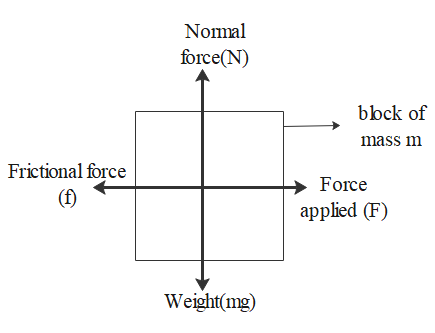
What is mu in physics?
Answer
492.6k+ views
Hint:The ratio of the frictional force resisting motion of two surfaces in contact to the normal force pressing the two surfaces together is known as the coefficient of friction. The Greek letter mu $\left( \mu \right)$ is usually used to represent it. Friction is developed when one surface is in contact with the other. It can be defined as a force that will be retarding an object from moving.
Complete step-by-step solution:
1.Friction is created when one surface rubs against another. It's a force that can stop an object from moving.
2. The Greek letter "mu" $\left( \mu \right)$ is assigned to the coefficient of friction, and it is unit less. The normal force on an object is multiplied by the friction force.
3.The Newton is the unit of friction (N). For static friction and kinetic friction, the coefficient of friction has different values.
4.The frictional force resists the force applied to an object in static friction, and the object remains at rest until the static friction force is overcome. The frictional force resists an object's motion in kinetic friction.
The frictional force can be written as,
$\vec{f}=\mu \vec{N}$
The forces acting on a block is shown below,

Note: Friction is the force that opposes motion between any two surfaces that come into contact with one another. Static, sliding, rolling, and fluid friction are the four types of friction. Solid surfaces experience static, sliding, and rolling friction. The normal force is the force exerted by surfaces to keep solid objects from passing through them. A contact force is a normal force. If the surfaces of a table and a box are not in contact, they cannot exert normal forces on each other.
Complete step-by-step solution:
1.Friction is created when one surface rubs against another. It's a force that can stop an object from moving.
2. The Greek letter "mu" $\left( \mu \right)$ is assigned to the coefficient of friction, and it is unit less. The normal force on an object is multiplied by the friction force.
3.The Newton is the unit of friction (N). For static friction and kinetic friction, the coefficient of friction has different values.
4.The frictional force resists the force applied to an object in static friction, and the object remains at rest until the static friction force is overcome. The frictional force resists an object's motion in kinetic friction.
The frictional force can be written as,
$\vec{f}=\mu \vec{N}$
The forces acting on a block is shown below,

Note: Friction is the force that opposes motion between any two surfaces that come into contact with one another. Static, sliding, rolling, and fluid friction are the four types of friction. Solid surfaces experience static, sliding, and rolling friction. The normal force is the force exerted by surfaces to keep solid objects from passing through them. A contact force is a normal force. If the surfaces of a table and a box are not in contact, they cannot exert normal forces on each other.
Recently Updated Pages
Why are manures considered better than fertilizers class 11 biology CBSE

Find the coordinates of the midpoint of the line segment class 11 maths CBSE

Distinguish between static friction limiting friction class 11 physics CBSE

The Chairman of the constituent Assembly was A Jawaharlal class 11 social science CBSE

The first National Commission on Labour NCL submitted class 11 social science CBSE

Number of all subshell of n + l 7 is A 4 B 5 C 6 D class 11 chemistry CBSE

Trending doubts
What is meant by exothermic and endothermic reactions class 11 chemistry CBSE

10 examples of friction in our daily life

One Metric ton is equal to kg A 10000 B 1000 C 100 class 11 physics CBSE

1 Quintal is equal to a 110 kg b 10 kg c 100kg d 1000 class 11 physics CBSE

Difference Between Prokaryotic Cells and Eukaryotic Cells

What are Quantum numbers Explain the quantum number class 11 chemistry CBSE




